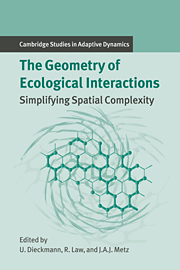Book contents
- Frontmatter
- Contents
- Contributing Authors
- 1 Introduction
- Part A Empirical and Statistical Background: A Plant Ecological Perspective
- Part B When the Mean-field Approximation Breaks Down
- Part C Simplifying Spatial Complexity: Examples
- Part D Simplifying Spatial Complexity: Techniques
- Introduction to Part D
- 18 Pair Approximations for Lattice-based Ecological Models
- 19 Pair Approximations for Different Spatial Geometries
- 20 Moment Methods for Ecological Processes in Continuous Space
- 21 Relaxation Projections and the Method of Moments
- 22 Methods for Reaction–Diffusion Models
- 23 The Dynamics of Invasion Waves
- 24 Epilogue
- References
- Index
- International Institute for Applied Systems Analysis
Introduction to Part D
Published online by Cambridge University Press: 14 January 2010
- Frontmatter
- Contents
- Contributing Authors
- 1 Introduction
- Part A Empirical and Statistical Background: A Plant Ecological Perspective
- Part B When the Mean-field Approximation Breaks Down
- Part C Simplifying Spatial Complexity: Examples
- Part D Simplifying Spatial Complexity: Techniques
- Introduction to Part D
- 18 Pair Approximations for Lattice-based Ecological Models
- 19 Pair Approximations for Different Spatial Geometries
- 20 Moment Methods for Ecological Processes in Continuous Space
- 21 Relaxation Projections and the Method of Moments
- 22 Methods for Reaction–Diffusion Models
- 23 The Dynamics of Invasion Waves
- 24 Epilogue
- References
- Index
- International Institute for Applied Systems Analysis
Summary
Introduction to Part D
Which systematic techniques can we apply for simplifying spatially explicit models in ecology? In the following chapters, we have assembled a menu of tools tailored to capturing and reducing spatial complexity. Chapters in this part are tutorials, each introducing or extending one method. They should help you to acquire the necessary skills for applying these techniques to ecological problems of your own choice.
The tools described in this part cover three complementary types of models in spatial ecology:
Probabilistic cellular automata and pair approximations (Chapters 18 and 19)
Dynamical point processes and moment methods (Chapters 20 and 21)
Deterministic continuum models and analyses of traveling waves (Chapters 22 and 23)
As we have seen in previous chapters, probabilistic cellular automata discretize ecological space into sites on a regular grid or on a more general contact network. On such a geometry, ecological dynamics unfold as sites change their states depending on states of adjacent sites. In contrast, individuals in dynamical point processes occupy locations in continuous space and thus are not restricted to any given set of sites; individuals may multiply, move, or disappear in response to other individuals present in their neighborhood. Ecological models of cellular automata and point processes are typically stochastic: two realizations of the same ecological process are unlikely to be identical. Continuum models are different: while individuals here are situated in continuous space, they are assumed to be so abundant that their spatial density distributions can be regarded as continuous and their dynamics as deterministic.
- Type
- Chapter
- Information
- The Geometry of Ecological InteractionsSimplifying Spatial Complexity, pp. 338 - 340Publisher: Cambridge University PressPrint publication year: 2000



